Related Research Articles

Entomology is the scientific study of insects, a branch of zoology. In the past the term "insect" was less specific, and historically the definition of entomology would also include the study of animals in other arthropod groups, such as arachnids, myriapods, and crustaceans. This wider meaning may still be encountered in informal use.

The Phasmatodea are an order of insects whose members are variously known as stick insects, stick-bugs, walking sticks, stick animals, or bug sticks. They are generally referred to as phasmatodeans, phasmids, or ghost insects. Phasmids in the family Phylliidae are called leaf insects, leaf-bugs, walking leaves, or bug leaves. The group's name is derived from the Ancient Greek φάσμα phasma, meaning an apparition or phantom, referring to their resemblance to vegetation while in fact being animals. Their natural camouflage makes them difficult for predators to detect; still, many species have one of several secondary lines of defense in the form of startle displays, spines or toxic secretions. Stick insects from the genera Phryganistria, Ctenomorpha, and Phobaeticus includes the world's longest insects.
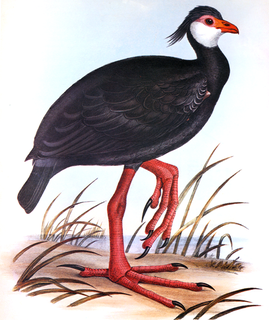
George Robert Gray FRS was an English zoologist and author, and head of the ornithological section of the British Museum, now the Natural History Museum, in London for forty-one years. He was the younger brother of the zoologist John Edward Gray and the son of the botanist Samuel Frederick Gray.

James Wood-Mason was an English zoologist. He was the director of the Indian Museum at Calcutta, after John Anderson. He collected marine animals and lepidoptera, but is best known for his work on two other groups of insects, phasmids and mantids.

William Forsell Kirby was an English entomologist and folklorist.

The Caelifera are a suborder of orthopteran insects. They include the grasshoppers and grasshopper-like insects, as well as other superfamilies classified with them: the ground-hoppers (Tetrigoidea) and pygmy mole crickets (Tridactyloidea). The latter should not be confused with the mole crickets (Gryllotalpidae), which belong to the other Orthopteran sub-order Ensifera.

Samuel Hubbard Scudder was an American entomologist and paleontologist. He was a leading figure in entomology during his lifetime and the founder of insect paleontology in America. In addition to fossil insects, he was an authority on butterflies (Lepidoptera) and grasshoppers (Orthoptera).

Roesel's bush-cricket, Roeseliana roeselii is a European bush-cricket, named after August Johann Rösel von Rosenhof, a German entomologist.

The wart-biter is a bush-cricket in the family Tettigoniidae. Its common and scientific names derive from the eighteenth-century Swedish practice of allowing the crickets to nibble at warts to remove them.
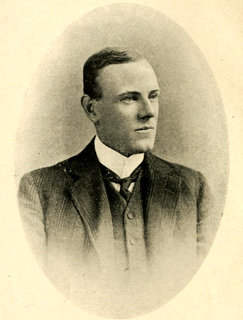
Robert Walter Campbell Shelford, was a British entomologist and museum administrator and naturalist, with a special interest in entomology and insect mimicry; he specialised in cockroaches and also did some significant work on stick insects.

The Phasmatidae are a family of the stick insects. They belong to the superfamily Anareolatae of suborder Verophasmatodea.

Megacrania batesii, commonly known as the peppermint stick insect, is an unusual species of stick insect found in northeastern Australia, the Bismarck Archipelago, the Solomon Islands, New Guinea, and possibly as far north as the Philippines. It is notable for its aposematic coloration, as well as its robust chemical defense mechanism. Its common name refers to the irritating fluid — with an odor resembling peppermint — that it sprays as a defensive action from a pair of glands located at its prothorax when threatened, as well as the cylindrical, twig-like shape of its body. A member of the subfamily Megacraniinae, it was first described by English naturalist and explorer Henry Walter Bates in 1865.

Eurycnema goliath, commonly known as the goliath stick insect, or the regal stick insect, is a large species of stick insect in the family Phasmatidae, endemic to Australia and considered one of the largest species of stick insects in the country. The species has the Phasmid Study Group number PSG14.
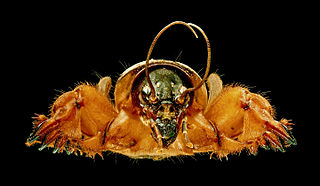
Gryllotalpa gryllotalpa, commonly known as the European mole cricket, is widespread in Europe and has been introduced to the eastern United States. The scientific name is derived from the Latin 'gryllus' meaning a cricket and 'talpa', a mole, and is descriptive because of the fine dense fur by which it is covered and its subterranean habits, and because of the mole-like forelegs adapted for digging, a good example of convergent evolution.
Daniel Otte is a noted behavior ecologist, a world expert on crickets and grasshoppers and a prominent scientific illustrator. He has made significant contributions to evolutionary biology. He is curator and chairman of the Department of Entomology at the Academy of Natural Sciences in Philadelphia.

The African rice grasshopper, Hieroglyphus daganensis is a medium-sized grasshopper species found in the Sahel region. Although not called a locust in English, this species shows gregarious behaviour and some morphological change on crowding and may become a moderately important pest species for small-holder farmers in the region.
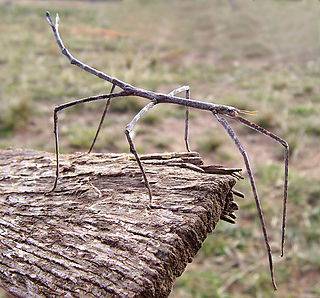
Ctenomorpha marginipennis, the margin-winged stick insect, is a species of stick insect endemic to southern Australia. The species was first described by George Robert Gray in 1833.
Denys Ovenden was a British natural history illustrator. His preoccupation with drawing began very early, probably around age three, since there are drawings on the fly-leaves of books from that period. His natural history interest began around age six.
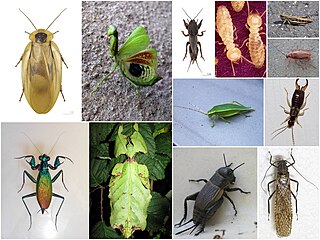
The cohort Polyneoptera is a proposed taxonomic ranking for the Orthoptera and all other Neopteran insects believed to be more closely related to Orthoptera than to any other insect orders. These winged insects, now in the Paraneoptera, were formerly grouped as the Hemimetabola or Exopterygota on the grounds that they have no metamorphosis, the wings gradually developing externally throughout the nymphal stages.
References
- ↑ "Our Experts - Phasmid Study Group". phasmidstudygroup.org. Retrieved 2020-01-21.
- ↑ "Museum Lives | Natural History Museum". www.nhm.ac.uk. Retrieved 2020-01-21.
- ↑ "Our Experts - Phasmid Study Group". phasmidstudygroup.org. Retrieved 2020-01-21.
- ↑ "About Us". IUCN. 2016-02-09. Retrieved 2020-01-21.
- ↑ "Orthoptera". Royal Entomological Society. 2017-05-25. Retrieved 2020-01-21.
- ↑ Marshall, Judith A.; Haes, E. C. M. (1990). Grasshoppers and Allied Insects of Great Britain and Ireland. Harley Books. ISBN 978-0-946589-36-4.
- ↑ "Grasshoppers – Field Studies Council". www.field-studies-council.org. Retrieved 2020-01-21.
- ↑ "Identifying british insects and arachnids annotated bibliography key works | Entomology". Cambridge University Press. Retrieved 2020-01-21.
- ↑ "Silent summer state wildlife britain and ireland | Ecology and conservation". Cambridge University Press. Retrieved 2020-01-21.